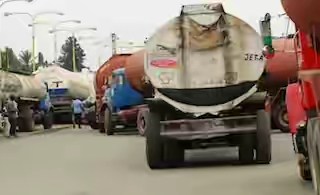Reasons why most Tankers are Cylindrical
We often see oil or water tankers in our city and areas, have you wondered why they are so cylindrical? Why do tankers only have a cylindrical shape, but no cube shape or an ideal box shape? While I was heading out yesterday, the thought bothered me, so I took my Infinix note 4, and started searching on net, I decided today to share my findings.
![Fuel-tankers-on-Nigeria-road.jpg]
( )
)
Fuel tankers on Nigeria road
A vehicle designed to transport liquefied cargoes such as water, high pressure gas or oil is called a tank truck. There are many types of oil tankers in terms of size, insulation, pressure holding capacity and type of transported liquid. A cylindrical shaped cistern has many advantages. The reasons are mentioned below:
More stability
A vehicle with liquids such as gas and liquefied combustible oils needs great stability for safe transport because the liquid has a property of maneuverability. To make the transportation successful, the distinct form of the tanker counts a lot.
The shape of the tanker must have a low center of gravity and this can only be achieved by a cylindrical tank. Rectangular or square tanks have a relatively high center of gravity, which endangers the stability of the vehicle.
No weak points
A cylindrical vessel has no structural weaknesses that require reinforcement. A rectangular or square container even has flat and lateral corners that can easily break under high pressure. This means that the conventional rectangular container will fall out faster than a cylindrical container.
Sloshing liquid
When an oil tanker accelerates or slows down, the liquid in the tank slides through the law of inertia, that is, "a body remains at rest in peace and a moving body continues to move until an external force of opposition acts on it”. The splash phenomenon is called surge. To reduce the Morse effect and shorten or accelerate the route, tankers have placed metal plates that reduce the flow of liquid in either direction. This is reason behind tanker drivers slowing down or carefully accelerating their tankers.
In addition, unlike other shapes, a spherical container absorbs blowout liquid better than other shape of tankers.
Extraction of liquid
A cylindrical container is more practical for extracting liquid from the cart in a simpler way than other shaped containers. This is because the liquid is carried to the bottom of a cylindrical tank and even the smallest amount of drops comes out. On the other hand, a rectangular tank would not allow the liquid to move to the vent point, and there will always be a quantity of product not funneled out.
Maintenance
A cylindrical container is easier to clean than any rectangular container, because in a box-shaped container, traces of liquid are trapped in the corners and, at the end, it is more difficult to remove. A cylindrical container does not contain angles, so cleaning is much easier.